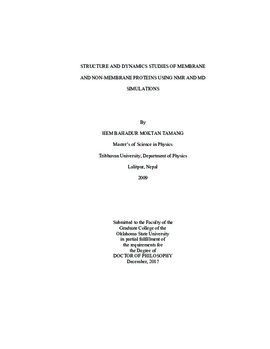| dc.contributor.advisor | Zhou, Donghua H. | |
| dc.contributor.author | Moktan Tamang, Hem Bahadur | |
| dc.date.accessioned | 2018-06-18T16:02:22Z | |
| dc.date.available | 2018-06-18T16:02:22Z | |
| dc.date.issued | 2017-12 | |
| dc.identifier.uri | https://hdl.handle.net/11244/300065 | |
| dc.description.abstract | The protein structural knowledge is essential in defining molecular recognition rules that power the understanding of basic biological phenomenon. The structures of most proteins are determinable due to advancement in technology and method development. Nuclear Magnetic Resonance (NMR) is one of the most versatile tools designed for this purpose. Proteins are flexible entities and dynamics play key role in their functionality therefore structures alone may provide only partial view on their functions. The experimental techniques have been used to study protein thermodynamics, but computer simulations have evolved to become the most convenient way to obtain the complete picture of protein dynamics. The central aim of this research is to study the structure and DNA binding dynamics of homologous pairing protein 2 (HOP2). In the first phase, the structure of N-terminal domain of HOP2 was investigated using NMR. It was identified with winged-helix DNA-recognition structural motifs. Furthermore, the DNA binding properties of this protein was investigated by NMR chemical shift perturbation method. It was found to bind to double-stranded DNA with considerable affinity, where structural motifs helix 3 (H3) and wing 1 (W1) were responsible for DNA recognition. Additionally, the site directed mutagenesis studies suggested H3 as the major contributor in DNA recognition. In the second phase, the DNA binding dynamics of HOP2 was investigated using classical MD simulations. Complexes of protein HOP2 and its mutants with DNA were constructed and then simulated using software GROMACS. Simulation results revealed the atomic level interactions between HOP2 and DNA, where H3 and W1 motifs engaged with DNA at major and minor grooves respectively. The effects on DNA binding due to point mutations in W1 and H3 were also observed. These effects were accessed in terms of changes in complex stability, binding free energy, and total number of interactions. The simulation results we obtained suggested that the motif W1 is also important as H3 in DNA binding. The NMR experimental and simulation protocol designed in this work will be useful in studying structure and dynamics of protein-protein or protein-ligand systems. | |
| dc.format | application/pdf | |
| dc.language | en_US | |
| dc.rights | Copyright is held by the author who has granted the Oklahoma State University Library the non-exclusive right to share this material in its institutional repository. Contact Digital Library Services at lib-dls@okstate.edu or 405-744-9161 for the permission policy on the use, reproduction or distribution of this material. | |
| dc.title | Structure and dynamics studies of membrane and non-membrane proteins using NMR and MD simulations | |
| dc.contributor.committeeMember | Xie, Aihua | |
| dc.contributor.committeeMember | Borunda, Mario F. | |
| dc.contributor.committeeMember | Hoff, Wouter D. | |
| osu.filename | MoktanTamang_okstate_0664D_15470.pdf | |
| osu.accesstype | Open Access | |
| dc.type.genre | Dissertation | |
| dc.type.material | Text | |
| thesis.degree.discipline | Physics | |
| thesis.degree.grantor | Oklahoma State University | |
